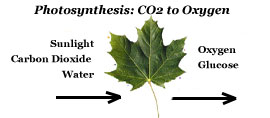How Does Carbon Sequestration Work?
Carbon Dioxide is a compound produced from the combustion of carbon-based fuels: the colorless, odorless, tasteless gas formed when carbon, a solid, is burned in the open air. Carbon dioxide has long been recognized as a major agent of climate change since it is known to block solar energy that would otherwise radiate back into space.
 |
 |
Once carbon is released into the atmosphere, one of the easiest ways to mitigate that gas is to plant trees to absorb it, since carbon is a gas that trees use to grow and reproduce during photosynthesis! Trees are so effective that an average tree is believed to absorb one ton of carbon dioxide over its normal lifetime.
Trees Sequester CO2
The average person in the U.S. generates approximately 2.3 tons of CO2 every year. An average healthy tree stores about 13 pounds of carbon annually – or 2.6 tons per acre each year.
A single mature tree can absorb carbon dioxide at a rate of 48 lbs per year and release enough oxygen back into the atmosphere to support two human beings.
If every American family planted just one tree, the amount of CO2 in the atmosphere would be reduced by one billion lbs annually. That is almost five percent of the amount that human activity pumps into the atmosphere each year. 300 trees can counter balance the amount of air pollution one person produces in a lifetime.
How To Reduce CO2
- Replace a regular incandescent light bulb with a compact fluorescent light bulb or LED bulb
- Use energy efficient household appliances like Energy Star products
- Insulate and weatherize your home, and switch to greener sources of power like wind or solar energy
- Plant trees! Plant LOTS of trees. Tree planting remains one of the cheapest, most effective means of drawing excess CO2 from the atmosphere.

